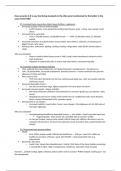How accurate is it to say that living standards in the USA were transformed for the better in the
years 1933-1960?
P1: Increased Home ownership, better house facilities + appliances
Increased quantity of houses built/available
o Levitt Company- mass production prefabricated houses, quick + cheap, more people could
afford
Increased home ownership
o 1920, 6,700,000 owned, 12,900,000 rented -----> 1940, 19,600,000 rented, 15,200,000
owned
Increased movement to suburbs (cities=overcrowded, slum-ridden),- aided by car infrastructure-
bigger houses, safer areas
Running water, bathrooms, lighting, cooking, heating, refrigeration, radio (82.8% owned radio in
1940)
Who was Excluded?
o Poorest couldn't afford houses even in 1960, Levitt (+other developers) refused to sell to
black Americans
o Migration to suburbs left cities in worse state than before, increased inequality
P2: Consumer Culture and leisure industry
1933, suffering from Great Depression (1/3 banks bankrupt), unemployment + homelessness
1941, US joined WW2, increased employment, boosted economy--> boom continued into post-war
affluence of 1950s and 1960s
More Leisure Time
o 1939 Fair Labor Standards Act (40-hour working week legal max., after war people took jobs
with fewer hours)
Increased disposable income
o Act also set minimum wage, higher proportion of income spent on leisure
Increased consumer goods + leisure activities
o War-time production shifted to meet demands for consumer goods (e.g. toy industry, 'baby
boom')
o Shopping became leisure activity (1956 world's first air-conditioned mall), movie theatres,
diners, tourism (Disneyland 1955), spectator sports
Development of car industry
o Increased mobility, travel further, faster, more cheaply, 1956 Highways Act (41,000 miles of
interstate highways)
Who was excluded?
o Unemployed had insufficient disposable income --> non-whites = hard to get jobs/equal pay
Huge inequality- 1956, richest 1% controlled 26% of country's wealth
o As cars got cheaper, poorest (who couldn't afford cheap car) suffered, decrease in non-car
transport infrastructure, rail travel too expensive, buses (crowded, dirty, predominantly non-
whites)
P3: Government anti-poverty policies
Health
o Early 1930s, people couldn't afford basic healthcare--> 1930 gov. spent $11 million on
healthcare provision, 1940 gov. spent $32,700,000--> decreased death rate (e.g.
tuberculosis)
Roosevelt's New Deal
o Switch from 'laissez-faire Republicanism', further 1944 State of the Union Address promising
a 'second bill of rights: right to employment, healthcare, education, food, housing'
However… Limited funding, highly criticized, policies didn't work in practice Often helped 'working poor' not
the unemployed




